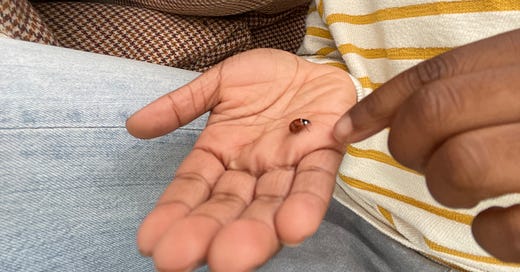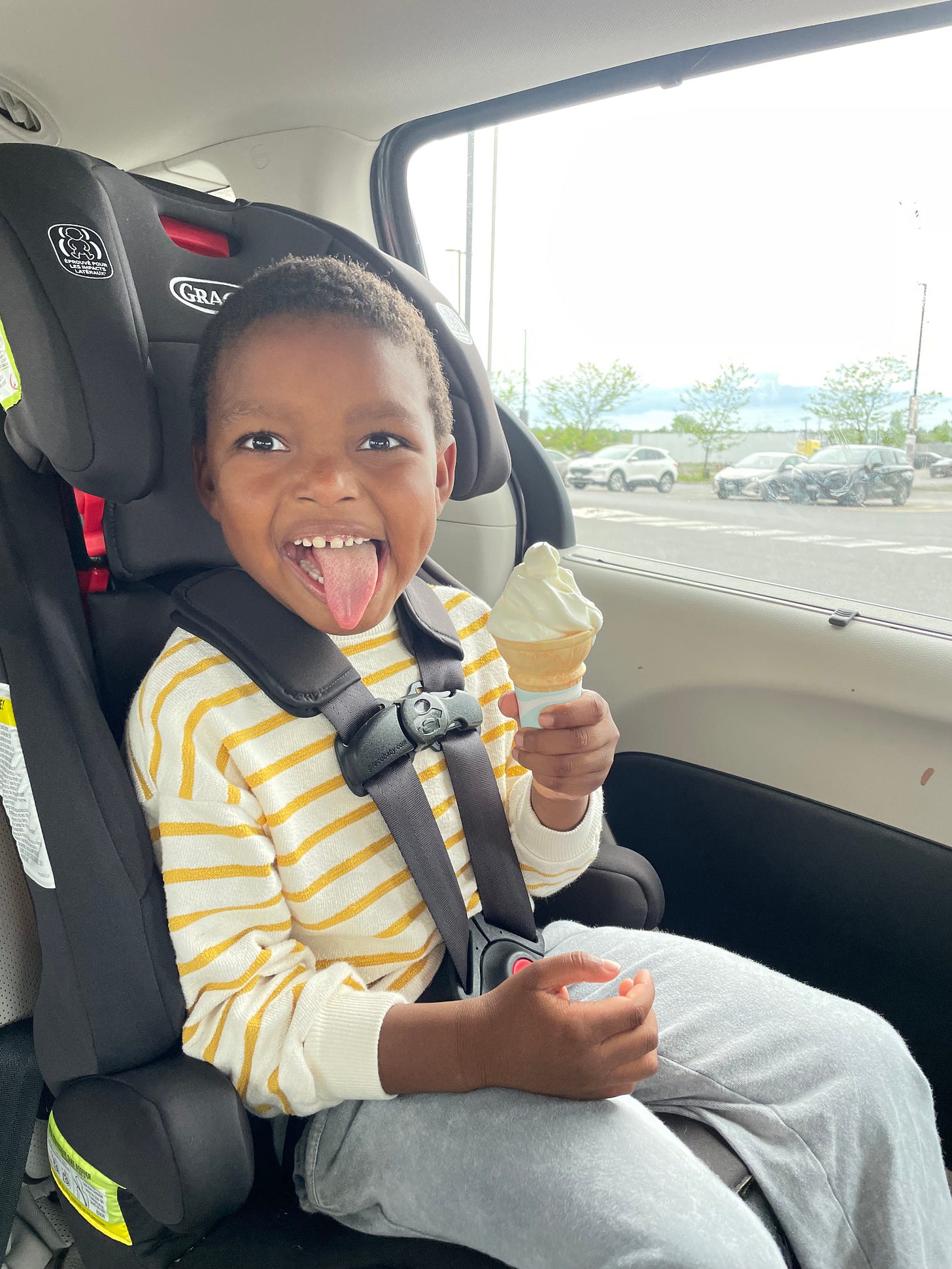Last weekend, while at the park near our house, Khalil picked up a ladybug, named it Spotty, and carried it home. On the way, he stopped at the flowers in front of our neighbor Ann’s house. “Look at these beautiful flowers, Spotty. Have you ever seen something like this?”
He showed Spotty around the house. “Now, this room might be new for you, Spotty, and new things can be scary, but I’ll keep you safe.”
He brought Spotty to the dining table for lunch and then to quiet time, building a little bug hut where Spotty could rest. Except when he absolutely had to put Spotty down, the ladybug crawled around his tiny fingers. He held Spotty for nearly six hours. “I think my favorite thing is when he stretches his little bug legs.” He told me, about a dozen times.
On Tuesday, Khalil went to the dentist. He was scared but they were gentle and let him take his time. After his appointment, he rushed home, eager to see the new lava lamp we had promised him. “I AM A BRAVE BOY!!!” he shouted, dancing down the hall and changing into a nightgown (he insists that we both wear them).
While Khalil climbed bravely into the dentist’s chair in Ontario, 3,000 miles away in Texas, 19 children and 2 teachers were murdered in their classroom. When I imagine the minutes in that classroom, it feels like my sternum could split in two. Those little babies, scared and confused and suffering. Those little babies dying. Babies who might have befriended a ladybug or braved the dentist. Tender, quirky, chaotic kids.
Tuesday was not an anomaly. In fact, as of 2020, gun violence is the leading cause of death for kids. Tuesday’s attack was only 10 days after a racially-motivated mass murder in a Buffalo grocery store. In 2022, more children have been killed in school than cops in the line of duty.
Like many parents, I didn’t sleep well on Tuesday night. I woke up crying at midnight and again the next morning. I kept thinking of that Maggie Smith poem, “Good Bones”.
The world is at least fifty percent terrible.
But it doesn’t have to be this way. Kids do not need to be executed while at school. Even if our hearts are tired and we feel like it might always be this way, we still need to try.
So, let’s try to figure out how this happens. We know that in countries with stricter gun laws, fewer people die from gun violence. While correlation doesn’t always mean causation, the number of times that stricter gun laws have preceded reduced violence in other countries is hard to ignore.
It also makes sense. If fewer people have guns, fewer people shoot guns at other people.
I’ve heard people say that focusing on guns is simplifying and politicizing a complex issue. That a number of factors have led us here. And sure, life is complicated. Just like car seats aren’t the _only_ thing that prevents children from dying in motor vehicle crashes, they sure do help. And if there is strong evidence that reducing the number of guns in circulation will reduce the number of children who are brutally killed, wouldn’t we want to do that? Even if it doesn’t solve the whole problem?
To be honest, I am baffled by the American obsession with firearms. Why do people want to carry murder metal around with them? Why do they need it in their house? Life is hard enough without holding in your hands the power to kill another person.
The first time I was impacted by gun violence was in 1994. For years, my extended family had been gathering in Pennsylvania for reunions. My second cousin, Jeremy, was six years my senior and, according to our gaggle of younger cousins, very cool. He was handsome and friendly and happy to spend the afternoon driving the tractor around the family farm, towing us kids in a wide wooden wagon. He let me drive the tractor once, patiently explaining the mechanics.
In April of 1994, my mom picked me up from school and told me the news. Jeremy had been in an argument with a friend. His friend pulled out a gun and shot him. Jeremy was dead.
I couldn’t stop thinking about the gun that his friend was holding. Why did he have it? Why did he need it? If anger had overwhelmed him, but he didn’t have a gun, would he have punched Jeremy instead? Kicked him? Would Jeremy still be alive?
I started telling anyone who would listen that I thought guns should be illegal.
In 2020, when we were still in North Carolina and our city’s social safety net offered inadequate protection against pandemic-related job loss and economic uncertainty, gun violence increased. In the year prior, we had heard gunshots twice but as the first pandemic spring turned to summer, we started hearing them multiple nights a week. Whichever neighbor witnessed the incident would email the rest of us about where shots had been fired and how many people were injured or dead. One neighbor made a joke: “It’s time for everyone’s favorite nightly gameshow: bullets or fireworks?”
Errant bullets entered a baby’s bedroom down the street from us. We got used to ducking below the window line when we heard the sounds close by and stopped even mentioning it — wordlessly reading or watching TV while sitting on the ground. We moved Khalil’s bed to a spot that we thought would be less likely to be hit by a stray. We stayed up researching how effective our house siding would be against a bullet. On July 4th, my sister visited our front porch and her toddler picked up a bullet.
We left for Canada three weeks later.
I can’t stop thinking about the people who value their right to own a gun over the protection of kids. That’s what it comes down to. Only 53% of voters in the US want stricter gun laws. The vast majority of Republicans do not. In fact, the majority of Republicans want laws that are less strict.
I truly want to understand this thought process. How could 47% of the US witness the massacre of children and not be willing to do anything possible to stop it from happening again? If one more child doesn’t die in the classroom, isn’t that worth having to wait 28 days to buy a gun, or having to wait until you’re 21? The vast majority of people who oppose stricter gun laws (or who don’t think gun law changes are a priority) would not lose access to their guns. They might simply need to wait a few extra days to obtain future guns.
I’ve spent hours reading studies on the motivation for gun ownership. People cite tradition, recreation, and protection. The first two reasons are subjective. I can’t argue the value or merit of another person’s tradition or recreation but I do have trouble thinking any form of entertainment is worth the life of a child. I understand that gun-related sports may be important to some people and families but, goodness, important enough to endanger the 8,000 children who are shot each year? That seems impossible. I can’t think of a single hobby or interest of mine that I care about that much.
As for the third, many unrelated studies make it clear: people who own guns are far more likely to be injured by their own guns than protected by their guns. Guns are a statistically ineffective means of protecting your family. People are terrible at predicting their own risks.
For those of us who are white, we must consider how our gun-related opinions are shaped by racism and privilege. A Black child is more likely to be injured by a gun than a white child but it’s not because there are more firearms in the home. A Black family is far less likely to own a gun and 82% of Black people believe gun violence is a major issue in the US. Only 39% of white people agree.
Only 45% of white voters want stricter gun laws while 75% of Black people do. Whose freedoms are white gun advocates protecting?
If you read my newsletter and find yourself slow to transition your mourning into action, I beg you to consider the roots of your ambivalence about gun reform. Our little tiny children need us to protect them. Contact your elected officials, donate to gun reform organizations. Consider making gun reform a deal-breaker when you vote.
David and I can still vote in the US, and boy do we. We are also donating and calling along with you.
We are thankful to be in Canada, where gun-related violence is far less common. The rate of gun homicides in the US is 600% higher than Canada. After moving, I was surprised to find that the lower rate of violence here is palpable. We breathe easier. Goodness, though, it shouldn’t take immigrating for us to feel safe sending Khalil to school.
We are thankful that since moving, Khalil has never had an active shooter drill. That we didn’t consider stray bullets when we picked his bedroom. That we have no idea if his backpack is bulletproof.
Please, vote, donate, and act as if every sweet baby deserves the same. We belong to each other.










This was so beautifully put. I heard today from one friend keeping her son home the rest of the week after a threat of a shooting and a second friend whose daughter had a BB gun brought to her fourth grade class. It is madness and we all need to take a stand.
I can see in your son's eyes the love and trust he has for you and that he brings to our world.Thank you for keeping him safe, loving him, giving him a wonderful foundation of kindness--that he already shows so sweetly, as to his ladybug friend. Thank you, thank you. With all the gun violence and tragedy around us, you are a warm reminder and inspiration. I know you have your own difficulties and challenges but you are courageous, filled with love and you are sharing your love, kindness and knowledge with this sweet, sweet soul. ALL of our children deserve the childhood yours is getting, but some of them, like your cousin, are shot down instead. My heart, my head, my soul cannot comprehend it. And I can't comprehend how our nation allows this.....Trying to stay positive about human nature, wishing you all GOOD. Love, Joan in California